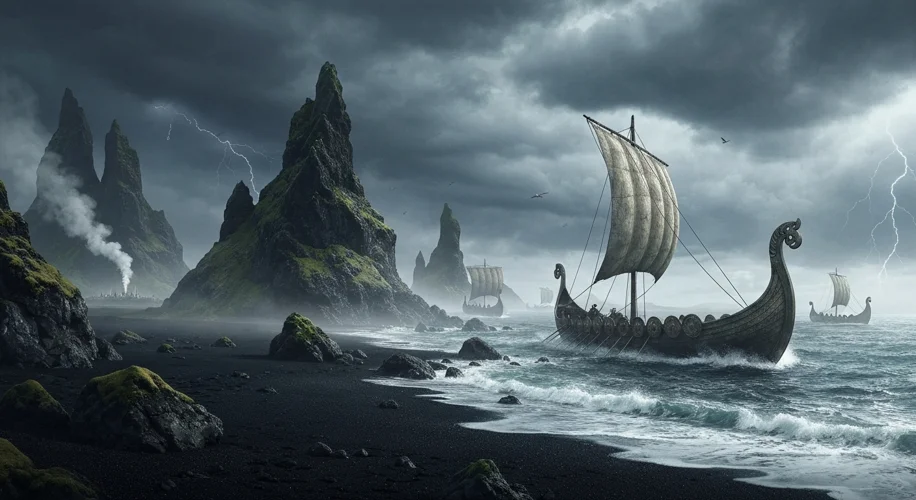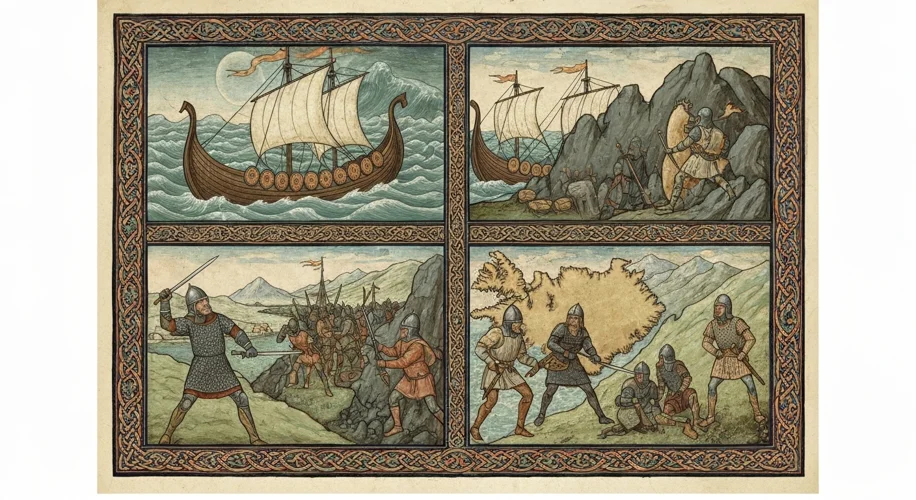In the vast, windswept expanse of the North Atlantic, a land of dramatic contrasts lay waiting. A place where fire breathes from the earth and ice carves monumental landscapes. This was Iceland, an island shrouded in myth and mystery, until the relentless curiosity of Norsemen began to chip away at its isolation.
Our journey begins not with a grand decree or a charted expedition, but with the whispers of misfortune and exploration carried on the icy currents. It was the late 9th century, a time when the Viking world was a dynamic, expansive force, pushing the boundaries of the known world. Driven by political upheaval and the lure of new lands, Norse seafarers, most famously the intrepid Ingólfr Arnarson, set their sights on the horizon.
The story of Iceland’s discovery is often attributed to Naddodr, a Norwegian sailor who, blown off course around 860 AD, became the first known European to sight the island. He called it “Snæland” – Snowland – a fitting, if temporary, moniker for this stark, beautiful land. However, it was the later arrival of Ingólfr Arnarson and his kinsman Leifur Hróðmarsson, around 874 AD, that truly marks the beginning of Iceland’s saga. Legend has it that Ingólfr cast his high-seat pillars overboard as he approached the island, vowing to settle wherever they washed ashore. They were eventually found in a bay that would become Reykjavík – the “Smoky Bay” – named for the geothermal steam rising from the earth.

But the island was not entirely uninhabited. Evidence suggests that Irish monks, known as the Papar, may have reached Iceland before the Norse, seeking solitude. However, their presence was fleeting, unable to withstand the more robust, organized settlement of the Norsemen. These settlers were not just rugged adventurers; they were farmers, craftsmen, and lawmakers, bringing with them the complex social structures and traditions of their Scandinavian homelands. They were driven by a desire for land, freedom, and a chance to forge a new society away from the consolidating power of Norwegian kings.
The early years of settlement, known as the Landnám (land-taking), were a testament to human resilience. The environment was unforgiving. Harsh winters, volcanic activity, and limited resources demanded an extraordinary level of adaptation. Yet, the settlers persevered, establishing farms, developing a unique sagaliterature that chronicled their lives and deeds, and creating a sophisticated form of governance known as the Alþingi, established in 930 AD at Þingvellir. This assembly, considered one of the world’s oldest parliaments, was where laws were made, disputes settled, and the collective identity of the Icelandic people was forged.
The cultural development of Iceland is as fascinating as its discovery. Isolated by vast stretches of ocean, the Icelanders developed a distinct identity. Their language, Old Norse, evolved with fewer external influences than its mainland counterparts, preserving a linguistic purity that is still remarkable today. The sagas, epic prose narratives detailing the lives of early settlers, their feuds, and their explorations, are not merely historical accounts but profound literary achievements that offer unparalleled insight into the Viking mindset, their honor codes, and their belief systems.

The conversion to Christianity in the year 1000 AD, a peaceful decision made at the Alþingi to avoid a religious schism, further shaped Icelandic culture, integrating it into the broader European Christian world while retaining many unique traditions. Over centuries, Iceland navigated periods of prosperity and hardship, including famines, volcanic eruptions, and even a devastating plague. Its history is a testament to the human spirit’s capacity to endure and thrive in the face of extreme adversity.
The impact of Iceland’s discovery and settlement is far-reaching. It represents a significant feat of exploration in the medieval period, pushing the boundaries of Norse expansion. The establishment of a functioning republic in such a remote location was a remarkable political achievement. Furthermore, the rich literary heritage of the Icelandic Sagas has provided invaluable historical and cultural insights, influencing literature and our understanding of the Viking Age for generations.
Iceland’s story is not just about finding a new land; it’s about creating a new world. It’s a narrative of courage, of resilience, and of the enduring human drive to build a home, no matter how harsh the environment. From the first glimpse of its snow-capped peaks to the roaring steam of its geothermal heart, Iceland remains a land shaped by its formidable landscape and the indomitable spirit of its discoverers and settlers.

